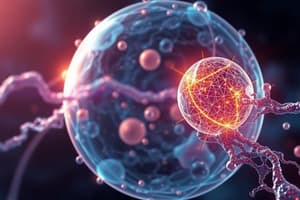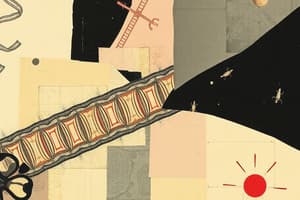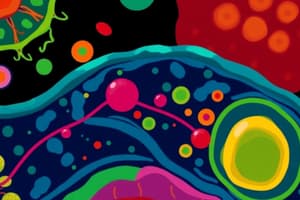Podcast
Questions and Answers
What is the primary function of enzymes in biological systems?
What is the primary function of enzymes in biological systems?
- To facilitate diffusion across cell membranes
- To store genetic information in cells
- To provide energy for cellular processes
- To act as biological catalysts for chemical reactions (correct)
Which of the following processes occurs during the Krebs cycle?
Which of the following processes occurs during the Krebs cycle?
- Synthesis of fatty acids
- Conversion of ATP to ADP
- Production of glucose from pyruvate
- Breaking down glucose into carbon dioxide and ATP (correct)
What is the role of transcription in genetics?
What is the role of transcription in genetics?
- Translating RNA into proteins
- Converting DNA into RNA (correct)
- Repairing mutations in DNA
- Making copies of DNA
Which factor is likely to lead to enzyme denaturation?
Which factor is likely to lead to enzyme denaturation?
What is the primary consequence of biodiversity loss?
What is the primary consequence of biodiversity loss?
Which of the following best describes an ecosystem?
Which of the following best describes an ecosystem?
What type of fermentation results in the production of ethanol?
What type of fermentation results in the production of ethanol?
Which of the following correctly defines a gene?
Which of the following correctly defines a gene?
Which statement accurately describes prokaryotic cells?
Which statement accurately describes prokaryotic cells?
What is the primary function of the Golgi apparatus?
What is the primary function of the Golgi apparatus?
During osmosis, water moves from which type of solution to another?
During osmosis, water moves from which type of solution to another?
What is produced during the light-dependent reactions of photosynthesis?
What is produced during the light-dependent reactions of photosynthesis?
Which organelles are specifically involved in energy production?
Which organelles are specifically involved in energy production?
Which mode of transport requires energy and moves substances against their concentration gradient?
Which mode of transport requires energy and moves substances against their concentration gradient?
How does anaerobic respiration differ from aerobic respiration?
How does anaerobic respiration differ from aerobic respiration?
Which statement best describes the role of chloroplasts in plants?
Which statement best describes the role of chloroplasts in plants?
Flashcards
Cell
Cell
The basic unit of life, characterized by various shapes and sizes optimized for their specific functions.
Prokaryotic cells
Prokaryotic cells
Cells lacking a membrane-bound nucleus and other organelles, such as bacteria and archaea.
Eukaryotic cells
Eukaryotic cells
Cells with a nucleus and membrane-bound organelles, found in plants, animals, fungi, and protists.
Diffusion
Diffusion
Signup and view all the flashcards
Osmosis
Osmosis
Signup and view all the flashcards
Photosynthesis
Photosynthesis
Signup and view all the flashcards
Cellular respiration
Cellular respiration
Signup and view all the flashcards
Aerobic respiration
Aerobic respiration
Signup and view all the flashcards
Enzymes
Enzymes
Signup and view all the flashcards
DNA Replication
DNA Replication
Signup and view all the flashcards
Transcription
Transcription
Signup and view all the flashcards
Translation
Translation
Signup and view all the flashcards
Biodiversity
Biodiversity
Signup and view all the flashcards
Ecology
Ecology
Signup and view all the flashcards
Populations
Populations
Signup and view all the flashcards
Communities
Communities
Signup and view all the flashcards
Study Notes
Cell Structure and Function
- Cells are the fundamental units of life, exhibiting diverse shapes and sizes tailored to their specific roles.
- Prokaryotic cells (bacteria, archaea) lack a membrane-bound nucleus and other organelles.
- Eukaryotic cells (plants, animals, fungi, protists) possess a nucleus and membrane-bound organelles, enabling compartmentalization of functions.
- Key organelles include the nucleus (managing cell activities), mitochondria (energy production), chloroplasts (photosynthesis in plants), endoplasmic reticulum (protein and lipid synthesis), Golgi apparatus (modifying, sorting, and packaging proteins), ribosomes (protein synthesis), vacuoles (storage).
- Cell membranes regulate the passage of substances into and out of cells through semi-permeable structures.
- Plant cells have a cell wall providing structural support.
Cell Transport
- Passive transport, requiring no energy, moves substances down their concentration gradient.
- Diffusion involves the movement of a substance from high to low concentration.
- Osmosis is the water movement across a selectively permeable membrane, from hypotonic (low solute) to hypertonic (high solute) solutions.
- Facilitated diffusion uses transport proteins to assist substance movement across the membrane.
- Active transport, using ATP, moves substances against their concentration gradient, from low to high concentration.
Photosynthesis
- Photosynthesis is the process where autotrophs convert light energy into chemical energy (glucose).
- This process occurs within chloroplasts, specifically the thylakoid membranes.
- Photosynthesis involves two stages: light-dependent reactions (capturing light energy) and light-independent reactions (Calvin cycle, producing glucose).
- Light-dependent reactions generate ATP and NADPH, fueling the light-independent reactions.
- Plants absorb carbon dioxide, incorporating it into glucose molecules during the Calvin cycle.
Respiration
- Cellular respiration is the breakdown of glucose to release energy in the form of ATP.
- Aerobic respiration, requiring oxygen, is the primary energy-producing pathway.
- Anaerobic respiration, without oxygen, yields less ATP compared to aerobic respiration.
- Cellular respiration involves three main stages: glycolysis (glucose splitting), Krebs cycle (further glucose breakdown), and electron transport chain (ATP production).
- Fermentation, such as lactic acid or alcoholic fermentation, is a type of anaerobic respiration.
Enzymes
- Enzymes are biological catalysts speeding up chemical reactions in living organisms.
- Enzymes are proteins with unique shapes, allowing for specific substrate binding.
- The active site of an enzyme is where the substrate binds.
- Enzyme activity is influenced by temperature, pH, and substrate concentration.
- Extreme temperatures and pH values can denature enzymes (disrupt their structure and function).
Genetics
- DNA, the genetic material, holds instructions for building proteins.
- Genes are DNA segments that code for specific proteins.
- DNA replication creates copies of DNA before cell division.
- Transcription produces RNA from DNA, carrying the genetic code to ribosomes.
- Translation converts RNA instructions into proteins at the ribosomes.
- Mutations are changes in the DNA sequence.
Biodiversity
- Biodiversity encompasses the variety of life on Earth, from genes to ecosystems.
- Biodiversity varies significantly across regions, mainly due to climate.
- Biodiversity offers both threats and benefits.
- Biodiversity includes species variety, ecosystem diversity, and genetic diversity within species.
- Species extinction is a natural process, but current extinction rates are elevated.
Ecology
- Ecology studies the interactions between organisms and their environment.
- Populations consist of individuals of the same species in a particular area.
- Communities comprise diverse populations interacting in an area.
- Ecosystems encompass interactions between populations, communities, and abiotic factors.
- Organisms interact through relationships such as competition, predation, and symbiosis (mutualism, commensalism, parasitism).
Studying That Suits You
Use AI to generate personalized quizzes and flashcards to suit your learning preferences.




